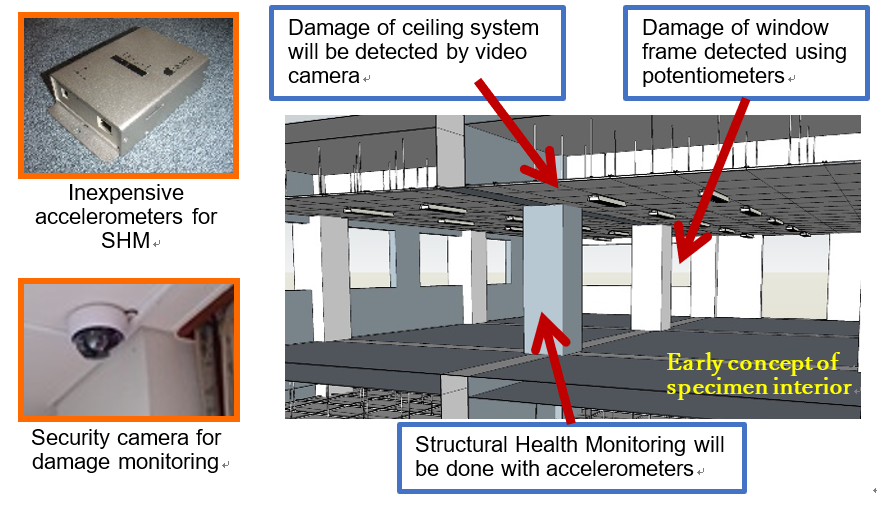Tokyo Metropolis is one of the most populated urban areas in the world and is a global economic power. However, it is located near the boundary between several tectonic plates and has a high risk of experiencing a strong seismic event. Such an event would cause widespread damage, and the time required to inspect buildings to judge its safety will be significant. This could result in a large portion of people and businesses being displaced from safe buildings unnecessarily during the evaluation process causing significant socioeconomic disruption, or for buildings with significant but hidden damage to be reoccupied. Due to this, there is a need to develop methodologies to rapidly and reliably evaluate a building’s safety following a major shaking event.
To address this need, the Tokyo Metropolitan Resilience Project was initiated to collect and synthesize data from E-defense tests (both past and planned), the seismographic network and field data on structural and non-structural damage to develop rapid building safety evaluation methodologies. There are five main themes related to this project:
I. Comprehensive loss assessment procedure in a pilot metropolitan residential area;
II. Enhancing the resiliency of buildings for disaster management and developing a health monitoring system to evaluate continuous functionality;
III. Holistic assessment of seismic damage in medical facilities;
IV. Functionality maintenance in indoor space;
V. Data acquisition, processing and utilization towards establishing a damage assessment system.
The E-defense test to be performed in December 2019 is part of Theme II. The 3-story reinforced concrete test specimen was designed to be representative of a disaster management center, such as city hall buildings in Japan. There are two objectives of this test; (i) to evaluate the performance of a damage-control detail proposed using spandrel walls monolithically casted with the frame elements, and (ii) to develop a system to indicate the level of damage for both structural and non-structural components based on various instrumentation readings.
(i) to evaluate the performance of a damage-control detail proposed using spandrel walls monolithically casted with the frame elements
(ii) to develop a system to indicate the level of damage for both structural and non-structural components based on various instrumentation readings.
The specimen will be fitted with a range of non-structural components such as ceilings, windows, wall tiles and roof plant. The building’s response and damage will be captured using accelerometers, video cameras, and laser scanners among other equipment, and will be used to evaluate the reliability of building safety evaluation methodologies.
東京都は、人口の多い世界有数都市の一つで、世界的経済大国となっています。しかし、ユーラシアプレート、太平洋プレート、フィリピン海プレートなどをはじめとする幾つかのプレート境界の近傍に位置しており、巨大地震の発生による危険性が危惧されています。大地震が発生すると首都圏は大きな被害を受けることになり、建物の安全性を評価するための即時判定が重要になります。しかし、建物の安全性確認が終わるまでは建物を使用することができず、仮に安全な建物であった場合、経済的な不利益を被ることになります。このようなことから、地震後の建物の安全性判断を迅速に行う手法を開発する必要があります。
これらの社会背景から、首都圏レジリエンスプロジェクトでは、過去や今後行う分も含め、Eディフェンスを活用した実大振動台実験に対するデータの収集と整備を始め、非構造物材を含む構造物の崩壊余裕度に関する即時安全性評価の手法を開発してきました。本プロジェクトでは、具体的な業務として,以下の5つの課題があります。
1.簡易・広域センシングを用いた広域被害把握・危険度判定;
2.災害拠点建物の安全度即時評価および継続使用性即時判定;
3.災害時重要施設の高機能設備性能評価と機能損失判定;
4.室内空間における機能維持;
5.データ収集・整備と被害把握システム構築のためのデータ管理・利活用検討
2019年12月にEディフェンスで実施する実大振動台実験は、サブプロジェクト(c)として行われます。3階建て鉄筋コンクリート造による試験体は、都市部において災害管理を行う建物を想定しています。この実験では、2つの目的があります。
(i) 垂壁・腰壁付きラーメンフレーム構造における損傷制御を把握するための性能を評価すること
(ii) 様々な計測値をもとに構造部材および非構造部材の損傷レベルを明示するためのシステムを開発することにあります。
試験体は、非構造物材として、天井材、窓、タイル壁、屋根なども付帯しています。建物の応答と損傷は、加速度センサー、ビデオカメラ、レーザー式変位計などの計測器類によってデータを収集し、それらの計測値をもとに建物の安全性評価を行うための手法を開発します。

